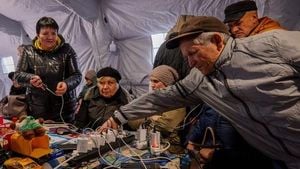Argentina’s financial landscape took a dramatic turn just days before a pivotal midterm election, as the nation’s central bank announced a $20 billion exchange-rate stabilization agreement with the U.S. Treasury Department. The deal, revealed on October 20, 2025, comes at a moment of acute economic anxiety in Buenos Aires, with the Argentine peso plummeting to a record low and the country’s reformist government under mounting political pressure.
According to Reuters, the agreement is designed to bolster Argentina’s monetary and exchange rate policy toolkit. The central bank stated, “Such operations will allow the BCRA to expand its set of monetary and exchange rate policy instruments, including the liquidity of its international reserves.” While the technical details remain under wraps, the timing—just six days ahead of the October 26 legislative elections—has fueled speculation about both the economic and political implications of the move.
For President Javier Milei and his economic team, the deal could hardly have come at a more critical juncture. The Argentine peso closed at 1,475 per U.S. dollar on the day of the announcement, down 1.7% and marking an all-time low. The currency’s relentless slide has become a symbol of the country’s ongoing struggles with inflation, capital flight, and dwindling confidence among both domestic and international investors.
U.S. Treasury Secretary Scott Bessent offered some insight into the structure of the agreement, explaining that the arrangement would be “backed by International Monetary Fund Special Drawing Rights held in the Treasury’s Exchange Stabilization Fund that will be converted to dollars.” In other words, the U.S. is leveraging its IMF resources to provide Argentina with much-needed liquidity, a move that underscores the gravity of the crisis facing South America’s second-largest economy.
Bessent was quick to clarify the conditions attached to American support. “The U.S. would not put additional conditions on Argentina beyond President Javier Milei’s government continuing to pursue its fiscal austerity and economic reform programs to foster more private-sector growth,” he said, as reported by Reuters. This stance signals continued U.S. backing, but only as long as Milei’s administration stays the course on painful reforms—an approach that has already sparked fierce debate within Argentina and beyond.
Since October 9, the U.S. Treasury has been quietly purchasing Argentine pesos in the open market in an effort to shore up the currency. Currency traders told Reuters that “sales of dollars into the peso market have reached hundreds of billions of dollars, though the source of the selling has not been disclosed.” Despite these interventions, the peso’s downward spiral has not abated, raising questions about the long-term effectiveness of the strategy.
Brad Setser, a former U.S. Treasury official now with the Council on Foreign Relations, voiced skepticism about the wisdom of the intervention. “There is a preponderance of evidence that the peso is significantly over-valued,” Setser said, citing indicators such as robust import and outbound tourism growth, Argentines shopping for cheaper goods in neighboring countries, and the central bank’s failure to meet IMF reserve accumulation targets. “It does seem to me that the Treasury is taking an unusually large risk of losing money in supporting the peso,” he added.
Yet, for Economy Minister Luis Caputo, the timing of the deal is crucial. He expressed hope last week that the framework would be finalized before the October 26 midterm parliamentary vote—a contest in which Milei’s party is seeking to expand its minority presence in the legislature. The outcome could prove decisive for the future of Milei’s reform agenda, which has been battered by recent political setbacks.
President Donald Trump, meanwhile, has positioned himself as a key player in the unfolding drama. On October 20, Trump publicly endorsed the $20 billion deal, framing it as a pragmatic, “transactional” move rooted in U.S. national interest. According to reporting by Jonathan Edwards and Dan Diamond, Trump has justified the intervention by pointing to Argentina’s dire financial straits and lack of resources. “The U.S. would not waste our time with Argentina if Milei’s party loses in the midterm vote,” Trump declared, in a statement that sent shockwaves through local markets.
However, Bessent quickly moved to clarify the administration’s position, emphasizing that continued U.S. support would depend on “good policies,” not simply the outcome of the election. A positive result for Milei’s party, he noted, would help block any efforts to repeal the hard-won reforms, but the core criterion remains the government’s commitment to fiscal discipline and market-friendly measures.
Trump’s approach to Argentina stands in marked contrast to his policy toward other Latin American nations. As reported by Jonathan Edwards and Dan Diamond, Trump has slashed aid to Colombia amid political disagreements, underscoring the transactional nature of his foreign policy. For Argentina, however, Trump has chosen to extend a lifeline—albeit one with strings attached and a clear expectation of reciprocal action.
The deal has not been without controversy in Washington. Some lawmakers and analysts have questioned the wisdom of committing such a substantial sum to a country with limited trade and security importance to the United States. Critics argue that the intervention could set a risky precedent, particularly given Argentina’s checkered history with international creditors and recurring bouts of economic instability.
Yet for the Milei administration and its supporters, the U.S. agreement represents a vital show of confidence at a moment of profound uncertainty. The central bank described the pact as “part of a comprehensive strategy to enhance its ability to respond to foreign exchange and capital markets volatility.” With the midterm elections looming, the hope is that the new influx of dollars will help stabilize the peso, reassure nervous investors, and give Milei’s party a fighting chance at the polls.
Still, the challenges ahead are formidable. The peso’s record low underscores the depth of Argentina’s economic malaise, and the government’s reform program faces stiff resistance from both opposition lawmakers and segments of the public weary of austerity. The coming days will test not only the resilience of Argentina’s financial system, but also the durability of its political institutions and the resolve of its leaders.
As the dust settles on the central bank’s surprise announcement, one thing is clear: the fate of Argentina’s economy—and perhaps its political future—hangs in the balance. With billions of dollars on the line and the eyes of the world watching, the stakes could hardly be higher.




